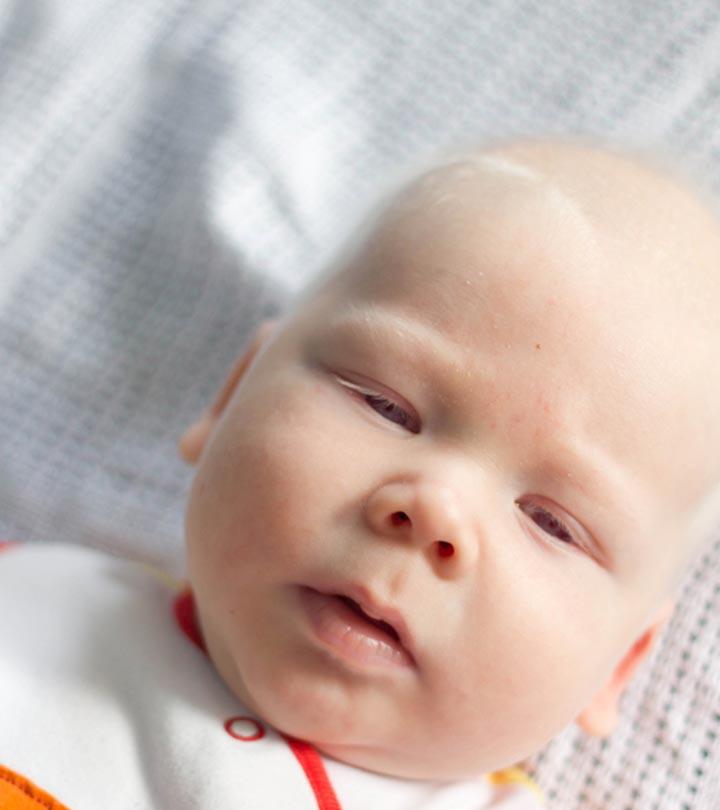Nystagmus is an ophthalmologic condition in which the eyes make repetitive, uncontrollable, random, jerky movements. Babies move their eyes to follow toys, voices, or people around them. This is normal in infants during vision development. However, babies with nystagmus have more frequent and constant eye movements. These eye movements can be multi-directional, including horizontal, vertical, or torsional.
Nystagmus is seen in about one in 5,000 live births and usually occurs between six weeks and six months of age (1). Various medical conditions can contribute to nystagmus. Nystagmus may even be associated with vision impairment or reduced vision in many babies.
Read this post to know about the causes, symptoms, risk factors, diagnosis, and treatment of nystagmus in babies.
Types Of Nystagmus In Babies
Nystagmus in babies is called infantile nystagmus, and it can be classified into the following two types (2).
1. Congenital nystagmus
Congenital nystagmus is present at birth or occurs within the first six months of life. This can be further classified into two types.
- Congenital sensory nystagmus: This is nystagmus due to something that interferes with visual information reaching the brain. Babies with congenital sensory nystagmus have abnormal vision. This is called afferent sensory defect since the sensory information, such as vision, to the brain is interrupted. Refractive errors, optic nerve and retinal problems, and congenital cataracts are common causes of this type of nystagmus in babies.
- Congenital motor nystagmus: According to the American Association for Pediatric Ophthalmology and Strabismus (AAPOS), congenital nystagmus is a more common type. Babies may have normal vision and no underlying causes of this type. This can be due to the brain lacking stability control or motor skills of eye movement. Brian and vision can be otherwise healthy other than nystagmus.
2. Acquired infantile nystagmus
Acquired nystagmus develops any time after six months of age. This can be due to various reasons such as brain abnormalities, eye and head trauma, and responses to certain medications. Imaging tests such as MRI scans help to identify the underlying causes of acquired nystagmus.
Infantile nystagmus can also be classified based on the eye movements into pendular nystagmus, where the eyes move at an equal velocity in each direction and jerk nystagmus when the eyes move fast to one direction and slowly to the opposite direction.
Signs And Symptoms Of Nystagmus In Babies
Rapid, involuntary, jerky eye movement is the primary symptom of nystagmus in babies. This can be uniplanar, pendular eye movement. The intensity and frequency of these eye movements may vary in each baby. Nystagmus may occur in one or both eyes. You may not notice eye movements when the baby is asleep.
Other symptoms of nystagmus in babies may include (3):
- Photosensitivity (sensitivity to light)
- Difficulty using eyes to follow objects
- Holding the head in a tilted position
Eyes are objectively normal in babies with nystagmus. There can be a null zone that is a position where the oscillations (nystagmus) are less, and the vision is good. Most babies with null zones adopt abnormal head positions for better vision.
Seek the consultation of a pediatric ophthalmologist if your baby has nystagmus. Some symptoms, such as blurred vision, night vision problems, dizziness, and balance issues, are more noticeable in older children.
Causes And Risk Factors For Nystagmus
Congenital neurological problems are the most common cause of nystagmus in babies. Some babies may develop neurological issues after birth. Other causes may include (3):
- Congenital cataracts
- Albinism
- Central nervous system illnesses
- Issues with the development of eye movement control
- High refractive errors, such as high myopia (nearsightedness) or astigmatism
- Inner ear inflammation
- Medications such as antileisure drugs
In addition, balance and vestibular disorders can also lead to nystagmus in babies. Diseases such as multiple sclerosis, stroke, and trauma may result in acquired nystagmus later in life.
Diagnosis Of Nystagmus In Babies
Doctors may observe the eye movements and head positioning of your baby. Detailed family history can be asked since congenital motor nystagmus can be hereditary. A visual acuity test is done in most babies. Congenital motor nystagmus can be associated with relatively better visual acuity than sensory defect nystagmus (4).
Light sensitivity with strabismus in bright light can be seen in some babies. Abnormal photopic cells are seen in electroretinograms. CT scan and MRI scan are needed to look for neurological causes of nystagmus. Congenital cataracts, ocular albinism, and optic nerve hypoplasia can be observed on a slit-lamp exam (5).
Treatment For Nystagmus In Babies
Nystagmus treatment primarily focuses on the correction of refractive error. Sensory deficit of vision in nystagmus cannot be corrected. Existing treatments strategies help to reduce the intensity and frequency of nystagmus.
Treatments for nystagmus may include (6):
- Pharmacological treatments: Various drugs such as diethyl propionate, baclofen, gabapentin, and botulinum toxin injection improve visual acuity and reduce the frequency of nystagmus.
- Surgical treatments: Kestenbaum-Anderson resection and other resection procedures are surgical treatments for improving abnormal head posture and reducing the frequency of eye movements. Tenotomy (eye muscle removal and reattachment) and extraocular muscle resection or a combination of these surgeries is also recommended.
- Vision rehabilitation: This is recommended for babies who are born with vision impairments, and may be considered as the baby grows older. Rehabilitation training teaches children to use electronic or optic magnification devices and other adaptive ways.
- Eyeglasses and contact lenses: Babies with refractive errors are provided with eyeglasses or lenses to correct the refractive error. These treatments do not correct nystagmus, and only improve vision. Eye patches are often recommended to prevent complications of refractive problems such as amblyopia (lazy eye).
All these procedures help improve nystagmus, but do not cure it. Babies may receive treatment for underlying causes of any issues that are present.
Frequently Asked Questions
1. Can nystagmus in babies go away?
The prognosis of nystagmus depends on the underlying cause. Babies may not outgrow congenital nystagmus due to developmental issues. Acquired nystagmus due to treatable conditions may go away after treating the underlying cause. For example, nystagmus due to exposure to certain medications may disappear when the compound is cleared from the body.
2. Is nystagmus linked to autism?
Autism and nystagmus may be linked. According to a population-based study in children younger than 18 years conducted using an optimum database, children with autism are nearly five times more likely to have nystagmus than children without autism (7). This study also found that autism could be linked to various ophthalmologic disorders (8). If your baby has nystagmus and you have concerns about their development, you may consult a doctor who is an autism spectrum disorder specialist.
Nystagmus is an ophthalmologic condition that can be hereditary and cannot be prevented in many babies. Seek medical care if you notice rapid eye movements in your baby. Early interventions may help to identify and manage vision problems and improve the quality of life. Acquired nystagmus may even be corrected if the underlying problem is fixed in a timely way.
References:
MomJunction’s articles are written after analyzing the research works of expert authors and institutions. Our references consist of resources established by authorities in their respective fields. You can learn more about the authenticity of the information we present in our editorial policy.



































